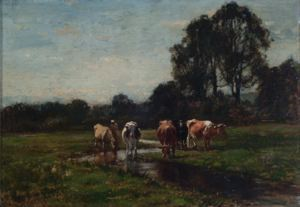
Mark Fisher
American, 1841–1923
Of all the American painters associated with French Impressionism, one of the earliest devotees was Boston native Mark Fisher. For an assortment of reasons, however, Fisher never achieved the fame of other disciples of the popular French movement. One explanation for his relative anonymity in the United States is that he moved permanently to Europe around 1872, finally settling in England. There he became a fixture in the art establishment. He exhibited at the Royal Academy regularly, was elected an associate in 1913, and a full academician in 1919. The English critic George Moore called Fisher, “the best landscape painter in England” and he lived there until his death in 1923.
Fisher’s parents were not prosperous, and he began work as an apprentice at the age of fourteen with his cousin, a sign and carriage painter. Subsequently Fisher took drawing classes at the Lowell Institute, and around the age of nineteen he met the painter George Cass (1831–1882), a student of the great landscape artist George Inness (1825–1894). Cass introduced Inness to Fisher, and Inness was impressed enough with the young man’s talent that he took him into his home and studio in Medfield, Massachusetts, to teach him landscape painting. In 1863, one of Inness’s patrons proposed sending the young student to Paris to study, and Fisher entered the atelier of the academic painter Charles Gleyre (1806–1874) where he shared instruction with artists such as Claude Monet (1835–1926), Pierre-Auguste Renoir (1841–1919) and Alfred Sisley (1839–1899), all later giants of the movement known today as French Impressionism. He returned to Boston, but found little success there professionally, and by 1872 he had returned to Europe, settling first in London and later in rural Sussex.
In 1885, Fisher was one of the founding members of the New English Art Club, an association that included John Singer Sargent (1856–1925), James McNeill Whistler (1834–1903) and Walter Sickert (1860–1942). These artists were adherents of the many French styles associated with plein air painting, and Fisher particularly was devoted to landscape. Massachusetts Meadow is exemplary of his subject and painting style; it is a relatively early work most likely painted just prior to his permanent relocation to Europe. The composition is characterized by dark forms silhouetted against a radiant sky glowing with filtered sunlight. The subject of cows in a pastoral landscape shows the continuing influence of the French Barbizon School (precursors of the Impressionists) that persisted in Fisher’s art throughout his career.
Mark Fisher, 1841-1923, The Impressionist: First Exhibition in America of the Work of this Boston Born Artist. Essay by M. L. D’Orange Mastai. Boston: Vose Art Gallery, 1962.
Gerdts, William H. American Impressionism. Seattle: The Henry Art Gallery, University of Washington, 1980, p. 39–40.
American, 1841–1923
Massachusetts Meadow
1872
Object Type:
Painting
Dimensions:
18 in. x 26 in. (45.72 cm x 66.04 cm)
Medium and Support:
Oil on canvas
Accession Number:
2018.0010.0003
Credit Line:
Gift of Babette L. Wampold in memory of Charles H. Wampold
Of all the American painters associated with French Impressionism, one of the earliest devotees was Boston native Mark Fisher. For an assortment of reasons, however, Fisher never achieved the fame of other disciples of the popular French movement. One explanation for his relative anonymity in the United States is that he moved permanently to Europe around 1872, finally settling in England. There he became a fixture in the art establishment. He exhibited at the Royal Academy regularly, was elected an associate in 1913, and a full academician in 1919. The English critic George Moore called Fisher, “the best landscape painter in England” and he lived there until his death in 1923.
Fisher’s parents were not prosperous, and he began work as an apprentice at the age of fourteen with his cousin, a sign and carriage painter. Subsequently Fisher took drawing classes at the Lowell Institute, and around the age of nineteen he met the painter George Cass (1831–1882), a student of the great landscape artist George Inness (1825–1894). Cass introduced Inness to Fisher, and Inness was impressed enough with the young man’s talent that he took him into his home and studio in Medfield, Massachusetts, to teach him landscape painting. In 1863, one of Inness’s patrons proposed sending the young student to Paris to study, and Fisher entered the atelier of the academic painter Charles Gleyre (1806–1874) where he shared instruction with artists such as Claude Monet (1835–1926), Pierre-Auguste Renoir (1841–1919) and Alfred Sisley (1839–1899), all later giants of the movement known today as French Impressionism. He returned to Boston, but found little success there professionally, and by 1872 he had returned to Europe, settling first in London and later in rural Sussex.
In 1885, Fisher was one of the founding members of the New English Art Club, an association that included John Singer Sargent (1856–1925), James McNeill Whistler (1834–1903) and Walter Sickert (1860–1942). These artists were adherents of the many French styles associated with plein air painting, and Fisher particularly was devoted to landscape. Massachusetts Meadow is exemplary of his subject and painting style; it is a relatively early work most likely painted just prior to his permanent relocation to Europe. The composition is characterized by dark forms silhouetted against a radiant sky glowing with filtered sunlight. The subject of cows in a pastoral landscape shows the continuing influence of the French Barbizon School (precursors of the Impressionists) that persisted in Fisher’s art throughout his career.
Mark Fisher, 1841-1923, The Impressionist: First Exhibition in America of the Work of this Boston Born Artist. Essay by M. L. D’Orange Mastai. Boston: Vose Art Gallery, 1962.
Gerdts, William H. American Impressionism. Seattle: The Henry Art Gallery, University of Washington, 1980, p. 39–40.
Portfolio List
Click a portfolio name to view all the objects in that portfolio
This object is a member of the following portfolios:
Your current search criteria is: All Object records.

 by Artist (743)
by Artist (743)
